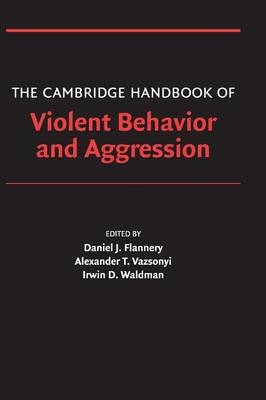
The Cambridge Handbook of Violent Behavior and Aggression
Cambridge University Press (Verlag)
978-0-521-84567-0 (ISBN)
- Titel erscheint in neuer Auflage
- Artikel merken
From a team of leading experts comes a comprehensive, multidisciplinary examination of the most current research including the complex issue of violence and violent behavior. The handbook examines a range of theoretical, policy, and research issues and provides a comprehensive overview of aggressive and violent behavior. The breadth of coverage is impressive, ranging from research on biological factors related to violence and behavior-genetics to research on terrrorism and the impact of violence in different cultures. The authors examine violence from international cross-cultural perspectives, with chapters that examine both quantitative and qualitative research. They also look at violence at multiple levels: individual, family, neighborhood, cultural, and across multiple perspectives and systems, including treatment, justice, education, and public health.
Dr Flannery is currently Professor of Justice Studies and Director of the Institute for the Study and Prevenetion of Violence at Kent State University. He was named a University Distinguished Scholar at KSU in 2006. He is a licensed clinical psychologist and an Associate Professor of Pediatrics at Case Western Reserve University and University Hospitals of Cleveland. He is co-editor of Youth Violence: Precention, Intervention, and Social Policy (1999) and author of Violence and Mental Health in Every Day Life: Prevention and Intervention for Children and Adolescents (2006). His primary areas of research are in youth violence prevention, the link between violence and mental health, and program evaluation. He received his PhD in 1991 in Clinical-Child Psychology from the Ohio State University. His previous appointments were as Assistant Professor of Family Studies at the University of Arizona, and as Associate Professor of Child Psychiatry at Case Western. He has published over 100 empirical articles and book chapters on youth violence prevention, delinquency, and parent-adolescent relations. He has also generated over $15 million in external support for his research. He has served as a consultant to various local and national organizations including the US Departments of Justice and Education, the Centers for Disease Control and Prevention, the National Crime Prevention Council, and the National Resource Center for Safe Schools. Dr Vazsonyi is currently the Professor of Human Development and Family Studies at Auburn University in Alabama. He has been a Fulbright Fellow, an Editor at the Journal of Early Adolescence, a Representative to the United Nations from Geneva and Vienna, and put on the Economic and Social Council for the American Society of Criminology. He is a reviewer for grants for the National Science Foundation, SAMHSA, the Department of Education, and reviews for over twenty journals. He has a particular interest in the application of a cross cultural and cross national comparative method of human development and violent behavior. Dr Waldman is currently a Professor of Psychology at Emory University, Atlanta. He is a clinical psychologist with developmental interests who examines the genetic and environmental etiology of disruptive behavior disorders in childhood and adolescence. His current research explores the role of candidate genes in the development of externalizing behavior problems, as well as genetic and environmental influences on comorbidity and on the links between normal variation in symptoms and in personality in the general population.
Introduction; Part I. General Perspectives: 1. Understanding violence; 2. Origins of violent behavior over the life span; 3. A review of research on the taxonomy of life-course persistent versus adolescence-limited antisocial behavior; Part II. Biological Bases of Violence: 4. Behavior-genetics of criminality and aggression; 5. The genetics of aggression in mice; 6. The psychophysiology of aggression: autonomic, electrocortical, and neuro-imaging findings; 7. Biosocial bases of violence; 8. Neurobiology of impulsive aggression: focus on serotonin and the orbitofrontal cortex; 9. The neuropsychology of violence; 10. The interaction of nature and nurture in antisocial behavior; Part III. Individual Factors and Violence: 11. Relational aggression and gender: an overview; 12. Personality dispositions and the development of violence and conduct problems; 13. Personality and violence: the unifying role of structural models of personality; 14. Exposure to violence, mental health and violent behavior; 15. Social-cognitive processes in the development of antisocial and violent behavior; 16. Self-control theory and criminal violence; Part IV. Interpersonal Factors and Violent Behavior: 17. Peers and violence: a two sided developmental perspective; 18. Youth gangs and violent behavior; 19. Family violence; 20. Youth violence across ethnic and national groups: comparisons of rates and developmental processes; 21. Adolescent dating abuse perpetration: a review of findings, methodological limitations, and suggestions for future research; 22. Social networks and violent behavior; 23. Public health and violence: moving forward in a global context; 24. Cross-national research on violent victimization; 25. Violent juvenile delinquency: changes, consequences, and implications; 26. Strain theory and violent behavior; Part V. Contextual Factors and Violent Behavior: 27. School violence; 28. Why observing violence increases the risk of violent behavior by the observer; 29. Violence and culture in the United States; 30. Terrorism as a form of violence; 31. Therapeutic treatment approaches to violent behavior; 32. Psychopharmacology of violence; 33. Social learning and violent behavior; 34. Substance use and violent behavior; 35. Poverty/ socioeconomic status and exposure to violence in the lives of children and adolescents; 36. Social contagion of violence; Part VI. Methods for Studying Violent Behavior: 37. Studying aggression with structural equation modeling; 38. Overview of a semi-parametric, group based approach for analyzing trajectories of development; 39. Relocating violence: practice and power in an emerging field of qualitative research; Part VII. Looking Toward the Future: 40. Violent behavior and the science of prevention; 41. New directions in research on violence: bridging science, practice and policy.
| Erscheint lt. Verlag | 3.9.2007 |
|---|---|
| Reihe/Serie | Cambridge Handbooks in Psychology |
| Verlagsort | Cambridge |
| Sprache | englisch |
| Maße | 183 x 260 mm |
| Gewicht | 1500 g |
| Themenwelt | Sozialwissenschaften ► Soziologie |
| ISBN-10 | 0-521-84567-X / 052184567X |
| ISBN-13 | 978-0-521-84567-0 / 9780521845670 |
| Zustand | Neuware |
| Haben Sie eine Frage zum Produkt? |
aus dem Bereich



